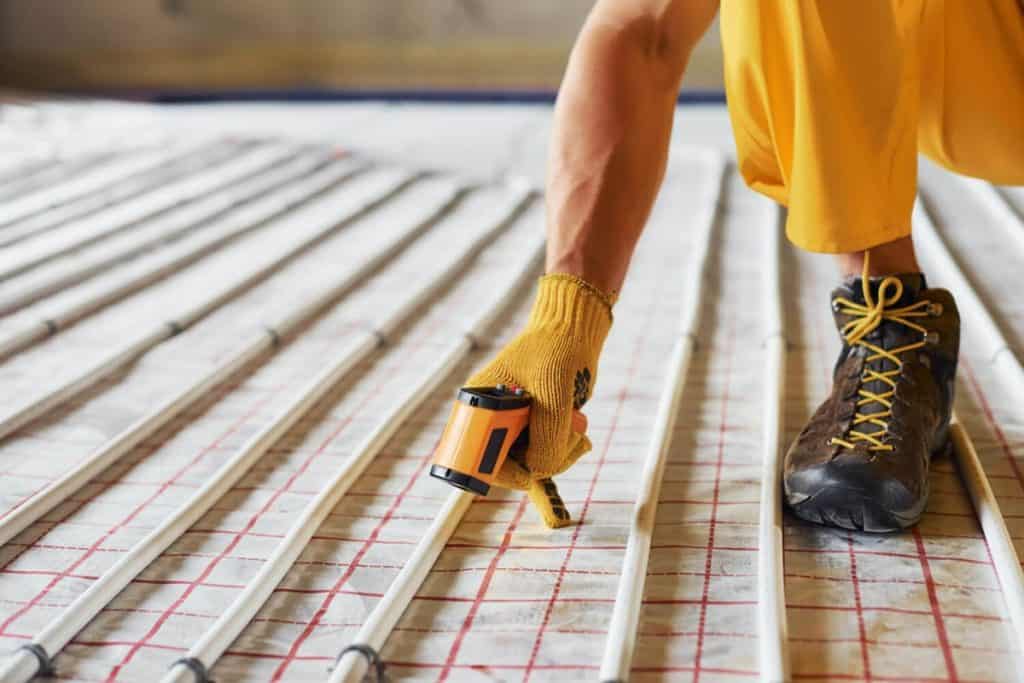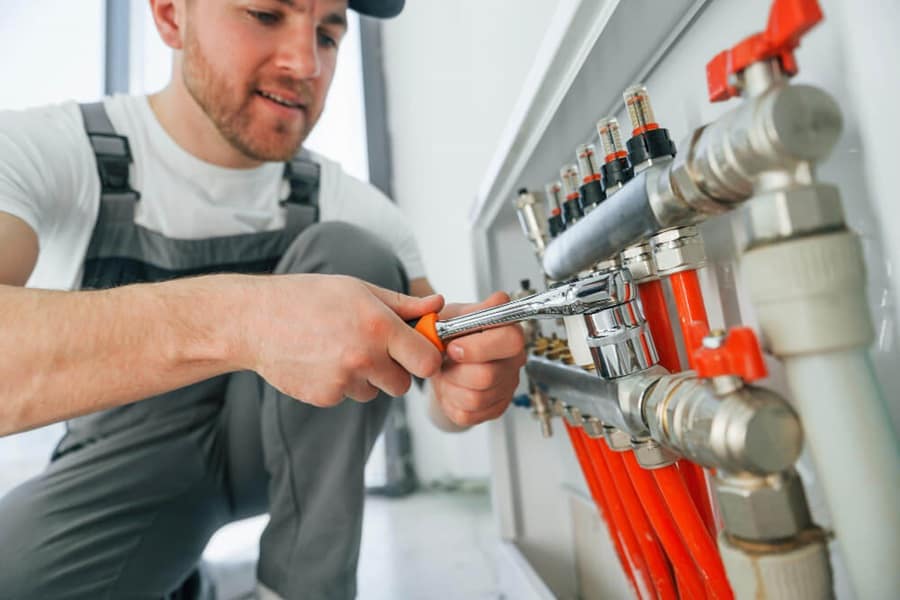
Do not underestimate the setup of installing underfloor heating…learn today why you should hire a professional rather than doing it yourself!
When considering an upgrade to your home’s heating system, underfloor heating is the way to go. Despite an initially high investment to setup, the long term benefits of UFH are unparalleled to other heating systems in your home. Unlike traditional wall heaters (radiators) that can unevenly heat a room and take up valuable wall space, underfloor heating offers a consistent and invisible solution, hidden away under your flooring.
However, the installation of the system is not to be taken lightly. In this article, you will understand the importance of, when installing underfloor heating, why hiring a professional is crucial for the optimisation of your underfloor heating system, as well as maintaining the integrity of your home, to answer the question – is underfloor heating diy a good idea?
Key points:
- Find out why hiring a professional to install underfloor heating is better than doing it yourself.
- Learn why temporary floor removal can be a risky process.
- Discover the balance between why you could install underfloor heating yourself versus hiring a professional.
The Importance of Professional Installation
Some homeowners may be tempted about installing underfloor heating diy themselves. However, the risk here is inevitably greater than the cost of hiring a professional, and it may even lead to unprecedented problems with underfloor heating, leading those to panic about why underfloor heating is not working. Here are some reasons that underline the importance of professionals installing underfloor heating versus doing it yourself.
Radiant Underfloor Heating Requires Temporary Floor Removal
No matter what type of flooring you have for your home, whether its timber, concrete, porcelain vs ceramic, vinyl or others, underfloor heating is mainly compatible for each of them. Considering the best flooring for underfloor heating in a new build or during renovations is the perfect time to explore radiant heating options.
Nevertheless, this task should be left to professionals to avoid gaps, leaks, or worse, inefficiency and potential injury due to improper installation. Your floors are literally what you stand on; ensuring their integrity and functionality is not compromised is essential.
Curious about doing underfloor heating yourself? Be aware of the certain dangers of underfloor heating.
Leave It To The Experts To Understand Common UFH Issues
Underfloor heating experts will have a better understanding of the type of flooring that best conducts and withstands heat, the common issues that may arise, and the optimal type of piping for your specific system. This knowledge ensures that your underfloor heating system requires minimal to no recurring maintenance, saving you time and money in the long run.
Depending on which type of underfloor heating kit you opt for, whether it’s a wet underfloor system, or an electric system, the costs can vary. A DIY mistake could escalate these costs significantly, not to mention the potential impact on the superior air quality that underfloor heating provides, especially for those who suffer with asthma. Therefore, hiring a professional for underfloor heating diy not only ensures a correct and efficient installation but can also prevent costly errors and personal injury.
Pros of Professional Underfloor Heating Installation

There has to be a balance between why you should consider hiring an expert to install your underfloor heating system, in case you are not already convinced:
1. Preparation
Correct floor preparation is critical, especially when using self levelling floor compounds. Professional installers ensure the area is adequately tanked to prevent screed cracking and unnecessary wastage.
2. Pipe Spacing
Expert installers pay close attention to pipe spacing, ensuring underfloor heating pipes, such as MLCP pipes, are fitted closer together in areas prone to higher heat loss in homes, such as near patio doors, for better efficiency.
3. Tools
The phrase “the right tools for the job” rings true in underfloor heating installation. Professionals use specialised underfloor heating tools like pipe decoilers and tacker guns to minimise waste and ensure a seamless installation, including crucial steps like how to bleed underfloor heating and pressure testing to prevent leaks.
4. Experience
The invaluable experience of professional installers guarantees a thorough understanding of underfloor heating systems, contributing to a swift and efficient installation process.
5. Speed
Professional installers typically complete the installation in half the time it would take a plumber or builder, minimising disruption to your project timeline.
6. Warranty
Many installers offer an additional warranty on top of the manufacturer’s product warranty, providing extra peace of mind.
7. Floor Removal
Removing the floor is a crucial step in installing underfloor heating, no matter whether it’s renovated, period, or new properties.
To lay the polyurethane tubes for hydronic heating systems, the floor must first be opened up. These tubes have to be accurately placed and anchored, requiring detailed attention to the installation site.
When the heating system is installed beneath carpeting, the carpet’s thickness is an important consideration. A carpet too thick could insulate the heat excessively, forcing the system to exert more effort to heat the space effectively. This increased effort could negate the energy efficiency benefits that underfloor heating is known for, impacting the anticipated cost savings.
Learn if rug vs carpet is compatible for your underfloor heating system.
8. Peace of Mind
Knowing that experienced professionals have installed your underfloor heating system correctly offers unmatched peace of mind, saving you from the hassle and cost of future repairs due to inexperienced workmanship.
Cons of Professional Underfloor Heating Installation
While the benefits are substantial, it’s essential to consider the drawbacks:
1. Cost
The primary concern is the upfront cost, which can be significant compared to a DIY approach. However, the long-term efficiency and avoidance of costly errors often justify this initial investment.
2. Limited Customisation
Professional installations may follow standard practices, which can limit customisation options for those with specific design preferences. However, you can still discuss this with your provider to determine the best approach with installing underfloor heating. For example, check our advice for underfloor heating design and construction.
Pros of DIY Underfloor Heating Installation
It is also important to be aware of the alternatives. If you are confident enough to perform underfloor heating setup and installation yourself (especially if you have a good understanding and knowledge of your house layout as well as the UFH kit) then here are the benefits of DIY:
1. Cost Savings
The obvious advantage of DIY is the potential for cost savings, especially with readily available underfloor heating kit builders. This could also be affected by the planned changes in the energy price cap for 2024.
2. Sense of Accomplishment
Installing your underfloor heating can offer a deep sense of accomplishment and improve your DIY skills.
3. Flexibility in Design
DIY allows for better customisation, enabling you to tailor the system to your room’s specific needs.
Cons of Underfloor Heating DIY Installation
Whilst you may feel confident enough to do underfloor heating installation yourself, it’s important to be aware of the risks and consequences if you slip up.
1. Technical Complexity
Underfloor heating systems involve specific technicalities that can be challenging for DIYers to master, even down to the matter of knowing how to repair underfloor heating.
2. Risk of Errors
Mistakes can lead to inaccuracies, increased energy consumption, and potential long-term damage.
3. Time and Effort
DIY installations require more attention to detail and can take significantly longer to complete.
Are you working on a new property? Learn about if underfloor heating adds value to new builds.
Fit Underfloor Heating Correctly With Our Expert Services

Choosing between professional or DIY approach for installing underfloor heating depends on various factors, including cost, time, technical skill, and the value you place on peace of mind and professional warranties. While the upfront cost of professional installation may be higher, the expertise, efficiency, and warranties offered by professionals often outweigh the potential savings of a DIY project.
With that being said, it is ultimately up to you, following this guide, on which option is right for installing underfloor heating. Be sure to check our customer feedback if you are still unsure.
Want to learn more? Discover how an underfloor heating probe can be used to aid your underfloor heating DIY installation.
FAQs
Do you need an electrician for installing underfloor heating?
Yes, an electrician is typically required for installing electric underfloor heating to ensure the system is safely connected to your home’s electrical supply, especially for the thermostat and control systems.
Do plumbers install underfloor heating?
Yes, plumbers are often involved in installing wet (hydronic) underfloor heating systems as these involve running water pipes beneath the floor, which requires plumbing expertise.
Can I install wet underfloor heating myself?
While it is possible to install wet underfloor heating yourself if you have good DIY skills, it is generally recommended to hire professionals due to the complexity of the installation, which involves plumbing and potentially connecting to your home’s boiler system.
What is involved in installing underfloor heating?
Installing underfloor heating involves several steps: preparing the subfloor, laying insulation, installing the heating elements (electric mats or water pipes), connecting to a power supply (for electric systems) or to the central heating system (for hydronic systems), and finally covering with the floor finish. The process requires careful planning and adherence to building regulations.
Sources
Ofgem. (2023) Changes to energy price cap from 1 January 2024. [online] Available at: https://www.ofgem.gov.uk/publications/changes-energy-price-cap-1-january-2024 [accessed 20/02/24]
